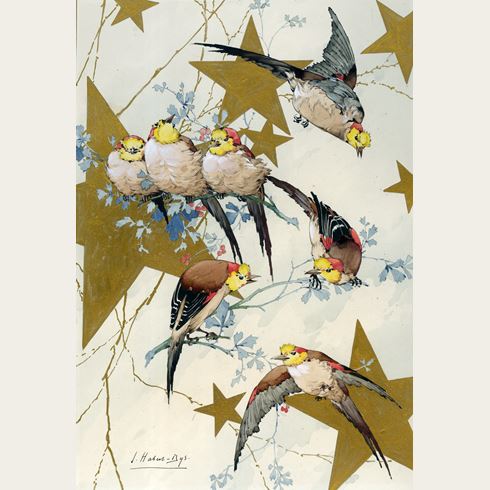Jules HABERT-DYS
(Fresnes 1850 - Paris 1930)
Illustration for Caprices Décoratifs: Oiseaux-mouches [Hummingbirds]
Signed J. Habert-Dys in black ink at the lower right.
260 x 180 mm. (10 1/4 x 7 1/8 in.)
This series of watercolours of birds are in superb, fresh condition, having been kept in an album since they were commissioned from Habert-Dys by Henri Laurens, the publisher of Caprices Décoratifs. The use of gold in many of these watercolours is a particular characteristic of much of the artist’s work. As the Weisbergs have pointed out, ‘Habert-Dys’ fondness for the use of gold, sometimes just a small speck in the overall design and at other times being employed more extensively, suggests that his designs were being developed for people of considerable wealth; any gold objects in their interiors would be matched by the gold on the plates which they were using for dinner ware.’
Established as one of the most creative and original designers in France, Habert-Dys earned one of the most significant commissions of his career in 1889, when the private ceramic firm of Pillivuyt asked him to design a table service to be exhibited at the Exposition Universelle that year. He was paid 15,000 francs for his work, and the service was much admired and written about by critics when it was shown at the Exposition Universelle, winning a gold medal. Apart from Pillivuyt, Habert-Dys worked for several other independent porcelain manufactories, and also produced drawings and designs for the Manufacture Nationale at Sèvres. In 1907 he was appointed a Professor at the Ecole Nationale des Arts Décoratifs, and worked there for the next two decades. In his spare time began to experiment with glassmaking techniques, and eventually his glass vessels, made with layers of both coloured and colourless glass, were exhibited at the Salon of 1913, where they won a Gold Medal. Habert-Dys never really recovered the heights of his career after the First World War, although he continued to produce designs for bookplates, illustrations, metalwork, glass and lacquer objects. Almost all creative activity ceased in 1922, however, when his wife became very ill and eventually died.
Provenance
Private collection.













